Upper Crossed Syndrome
Exposure of the human body to gravity forces, e.g., when standing or walking, is necessary to ensure proper activity of the skeletal muscles responsible for maintaining good body posture. When these muscles are not stimulated to resist gravity for an extended period, e.g., during prolonged sitting or lying, their stabilising function is disturbed and as a result mobilising muscles have to take over. However, the side effect of these compensatory changes is a period of hyperactivity followed by decreased flexibility which may lead to postural changes such as upper crossed syndrome or degenerative changes.
The “crossed” in upper crossed syndrome refers to the crossing pattern of the overactive muscles with the countercrossing of the underactive muscles. When viewed from the side, an X pattern can be drawn for these two sets of muscles. The tight muscles are the suboccipitals, upper trapezius and levator muscles, whereas the weak muscles are the cervical flexors, rhomboids and lower traps.
This pattern of imbalance creates joint dysfunction within certain areas of the spine as well as the shoulder joint. These dysfunctions can cause neighbouring spinal segments to change in morphology.
People with upper crossed syndrome will present with:
If you are diagnosed with upper crossed syndrome the Chiropractors at WYLD will deliver gentle yet effective adjustments into the spine to help facilitate the correction of your posture and encourage the muscles to support a healthy functioning spine. Stretches and strengthening exercises may be given to help improve range of motion within the spine. This will also allow the muscles to work in harmony rather than individualised muscle groups helping to improve the overall functioning of the body.
Our Approach For Chiropractic Care
Gentle and effective treatment
Comfort with state of the art Chiropractic equipment
Safe for people of all ages
What To Expect At Your First Chiropractic Visit
An initial Chiropractic exam will typically have three parts: a consultation, case history, and physical examination.
Laboratory analysis and X-ray examination may be performed.
Consultation. The patient meets with the chiropractor and provides a brief synopsis of lifestyle factors and concerns, such as:
Duration and frequency of symptoms
Description of the symptoms (e.g. burning, throbbing)
Areas of pain
What makes the pain feel better (e.g. sitting, stretching)
What makes the pain feel worse (e.g. standing, lifting)
Lifestyle factors
Case history. The chiropractor identifies the area(s) of complaint and the nature of the stress involved by asking questions and learning more about different areas of the patient's history, including:
Family history
Dietary habits
Past history of other treatments (chiropractic, osteopathic, medical and other)
Occupational history
Psychosocial history
Other areas to probe, often based on responses to above questions
Physical examination. A chiropractor may utilize a variety of methods to determine the spinal segments that require chiropractic treatments, including but not limited to static and motion palpation techniques determining spinal segments that are hypo mobile (restricted in their movement) or fixated. Depending on the results of the above examination, a chiropractor may use additional diagnostic tests, such as:
X-ray to locate subluxations (the altered position of the vertebra)
A device that detects the temperature of the skin in the paraspinal region to identify spinal areas with a significant temperature variance that requires manipulation.
Chiropractors are trained in a variety of methods to assess the underlying cause of the problem, including:
Evaluation and management services. Chiropractors are trained in examining the joints, bones, muscles and tendons of the spine, head, extremities and other areas of the body with the purpose of noting any misalignment, tenderness, asymmetry, defects or other problems.
Neurologic and other common physical examination procedures. Chiropractors are trained to perform a variety of neurologic tests (nerve root compression/tension, motor strength, coordination, deep tendon and pathological reflexes, etc.) and are skilled in performing orthopedic, cardiovascular and many other common examinations.
Specialised assessment. Chiropractors are trained to assess range of motion, stability, muscle strength, muscle tone and other assessments with the lower back.
Common diagnostic studies. Chiropractors are trained in use of diagnostic studies and tools such as radiography (X-rays), laboratory diagnostics and neurodiagnostics.








